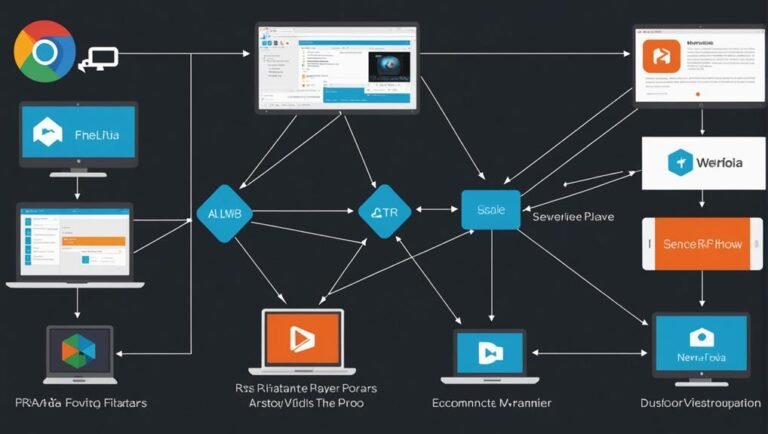When you’re deciding between RTP (Real-time Transport Protocol) and UDP (User Datagram Protocol), it helps to understand their differences. RTP is tailored for audio and video streaming, ensuring low latency and ordered delivery, making it great for applications like video conferencing. On the other hand, UDP prioritizes speed and efficiency, lacking built-in error correction, which suits real-time scenarios where some data loss is acceptable. In short, RTP is your go-to for high-quality multimedia, whereas UDP fits faster, less sensitive tasks. If you’re curious about which protocol fits your needs best, there’s plenty more to explore.
Overview of RTP
When you plunge into the world of real-time communications, you’ll quickly encounter the Real-time Transport Protocol (RTP). This protocol is designed to facilitate the delivery of audio and video over networks, making it crucial for applications like video conferencing, streaming, and online gaming. RTP’s benefits are clear; it provides minimal latency and guarantees that your media packets arrive in order, maintaining the integrity of your real-time experience. You can enjoy seamless conversations or smooth streaming without the annoying glitches that can come with lower-quality protocols.
However, it’s important to be aware of RTP limitations. While it excels in delivering real-time data, RTP doesn’t guarantee packet delivery or manage congestion, which can lead to an inconsistent experience under certain conditions. If packets are lost, the protocol doesn’t have built-in mechanisms to request retransmissions, forcing you to rely on other layers for that support. This might create some hurdles in your quest for freedom in communication, especially in less reliable network environments.
Overview of UDP
UDP, or User Datagram Protocol, is a fundamental protocol in the Internet Protocol suite that facilitates the transmission of data across networks. If you’re looking for speed and efficiency, UDP is your go-to choice. Unlike its counterpart TCP, it doesn’t guarantee reliability, which means you can experience packet loss during transmission. This lack of UDP reliability can be a double-edged sword; it allows for faster data transfer, but it may not be ideal for applications where every bit of data counts.
One key aspect of UDP is its simplicity, which is reflected in its UDP header. The header is streamlined, containing only essential information, making it less cumbersome than TCP’s. However, this simplicity leads to challenges like UDP fragmentation, where packets can get split into smaller pieces, potentially complicating data reassembly.
The UDP checksum provides a basic level of error checking, ensuring that the data sent is received intact. While UDP doesn’t focus on congestion control, its lightweight nature often leads to improved UDP performance, especially for real-time applications like gaming, voice, and streaming.
When it comes to UDP applications, you’ll see it thriving in scenarios where speed is vital, and the occasional dropped packet is tolerable. However, this lack of built-in security features means you should be cautious about UDP security concerns, especially over untrusted networks. Understanding these factors will help you make informed choices about when to use UDP and how it fits into your networking needs.
Key Features of RTP
Real-time Transport Protocol (RTP) boasts several key features that make it fundamental for delivering multimedia content over networks. If you’re diving into multimedia streaming, you’ll quickly see how RTP enhances your experience. Here are some standout features you should know about:
- RTP Packetization: RTP breaks down large multimedia streams into smaller packets. This isn’t just about making things fit; it guarantees efficient transmission and reduces latency, which is essential for real-time applications like video conferencing.
- RTP Timestamping: Each RTP packet comes with a timestamp that indicates when the data should be played. This feature helps maintain synchronization between audio and video streams, guaranteeing a seamless playback experience.
- Payload Type Identification: RTP can identify the type of data being transmitted, whether it’s audio, video, or something else. This flexibility allows for dynamic adjustments based on the media type, making it adaptable to various streaming scenarios.
- Support for Multiple Streams: RTP can handle multiple media streams simultaneously, such as when you’re watching a video with multiple audio tracks. This capability is significant for enhancing user choice and experience.
These features collectively empower RTP to deliver high-quality multimedia content over the internet. Embracing RTP means embracing a protocol designed for the demands of real-time streaming, making it a go-to choice for developers and users seeking freedom in online communication.
Key Features of UDP
When you think about UDP, one of its standout features is its connectionless communication protocol. This means you can send data without establishing a connection first, which greatly reduces latency. If you’re looking for speed in data transmission, UDP’s low latency advantages make it a compelling choice.
Connectionless Communication Protocol
In the domain of networking, the User Datagram Protocol (UDP) stands out as a connectionless communication protocol, delivering data without establishing a dedicated end-to-end connection. This approach lets you enjoy greater flexibility and efficiency in your applications. You won’t have to deal with the overhead of connection management, which means lower latency and a streamlined data transfer process.
Here are some key features of UDP that highlight its strengths:
- Packet Delivery: Data packets are sent independently, allowing for faster transmission.
- Error Correction: While UDP doesn’t provide built-in error correction, it empowers applications to handle errors as they see fit.
- Transmission Efficiency: With minimal protocol overhead, you can maximize your bandwidth for actual data, enhancing performance.
- Application Compatibility: UDP is versatile and works well with various applications, making it a popular choice for real-time services.
Low Latency Advantages
Low latency is one of the standout advantages of using UDP, making it ideal for applications that require quick data transmission. If you’re looking for speed and efficiency, UDP’s connectionless nature allows it to bypass the overhead associated with establishing and maintaining a connection, resulting in latency optimization. You won’t be bogged down by waiting for acknowledgments or retransmissions, which is essential in fast-paced environments.
For real-time applications, like online gaming or video conferencing, every millisecond counts. UDP’s minimal delay guarantees your data packets reach their destination swiftly, allowing for seamless interaction. You get that freedom to communicate without the hindrance of lag, making your experience smoother and more enjoyable.
Moreover, UDP’s ability to handle high traffic without significant slowdown means you can scale your applications without compromising performance. So, whether you’re streaming your favorite game or chatting with friends, you can relish the responsiveness that UDP provides. By leveraging low latency, you can engage in real-time experiences that truly captivate, giving you the freedom to connect and communicate like never before.
Use Cases for RTP
When you think of RTP, video streaming applications and VoIP communication systems are likely the first use cases that come to mind. These technologies rely on RTP to deliver real-time audio and video with minimal latency. Let’s explore how RTP enhances your experience in these scenarios.
Video Streaming Applications
For anyone involved in video streaming applications, RTP (Real-time Transport Protocol) proves to be vital. It allows for seamless delivery of audio and video over IP networks, making it the go-to choice for real-time communication. When you’re working with various video codecs, RTP guarantees that you’re getting the most out of your streaming experience.
Here are some key benefits of using RTP for video streaming:
- Low Latency: RTP minimizes delays, essential for live events and interactive sessions.
- Dynamic Payload Types: It supports multiple video codecs, allowing flexibility in streaming formats.
- Sequence Numbers: These help maintain the order of packets, reducing the chances of jitter.
- Timestamping: RTP provides vital timing information, necessary for synchronization in video playback.
RTP also plays a significant role in bandwidth management, making sure that you’re optimizing your streaming quality without overloading your network. By leveraging RTP, you can create a more enjoyable and efficient streaming experience, empowering you to share content freely and effortlessly. So, if you’re looking to enhance your video streaming applications, RTP is a protocol you can’t overlook.
VoIP Communication Systems
RTP’s advantages in video streaming also extend to VoIP (Voice over Internet Protocol) communication systems, where real-time audio delivery is paramount. With the rise of remote work and virtual communication, VoIP has become essential for seamless conversations. By integrating SIP (Session Initiation Protocol), you can establish and control your calls effectively, ensuring a smooth experience.
When it comes to codec selection, RTP supports various audio codecs, allowing you to choose the one that best fits your bandwidth and quality needs. This flexibility empowers you to optimize your audio quality without sacrificing performance. Additionally, network security is important for protecting your communications. RTP can work alongside secure protocols to safeguard your data, giving you peace of mind.
Another significant aspect of VoIP systems is jitter buffering. Since RTP transmits packets over the internet, it can experience variations in arrival times, or jitter. By implementing jitter buffering, you can minimize disruptions in your audio stream, enabling clear conversations. With these features, RTP enhances VoIP communication, ensuring you stay connected and free to express yourself without compromise.
Use Cases for UDP
User Datagram Protocol (UDP) is widely utilized in scenarios where speed is prioritized over reliability. You’ll find UDP applications in various fields, particularly where real-time data transmission is vital. For instance, online gaming and live streaming services often rely on UDP because they can’t afford delays. If a packet gets lost, it’s usually better to lose a bit of data rather than experience lag.
Consider these common use cases for UDP:
- Voice over IP (VoIP) and Video Conferencing: These applications need immediate data delivery.
- Online Gaming: Speed is key, and occasional packet loss is tolerable.
- Broadcasting and Multicasting: UDP makes it easy to send data to multiple recipients without overhead.
- DNS Queries: Fast resolution is essential, and a quick retry is preferred over waiting for a slower connection.
While UDP’s speed is a significant advantage, you should also consider UDP security. Since it lacks built-in mechanisms for ensuring data integrity, you might want to implement additional security measures, like encryption, to protect sensitive information. Overall, UDP shines in environments where real-time performance is important, and a little bit of data loss is acceptable. If you’re looking to optimize your applications for speed without worrying too much about reliability, embracing UDP might just be the right choice for you.
Performance Comparison
While both RTP (Real-time Transport Protocol) and UDP (User Datagram Protocol) serve essential roles in transmitting data, their performance can vary considerably based on the use case. When you’re looking at real-time applications, latency impacts and packet loss become critical factors. RTP is designed to handle these issues more effectively, making it better suited for applications like video conferencing or online gaming. On the other hand, UDP is simpler and faster, but it lacks the built-in mechanisms to manage packet loss.
To help visualize the differences in performance, here’s a comparison table:
| Protocol | Latency Impacts | Packet Loss Handling |
|---|---|---|
| RTP | Low latency, prioritizes timely delivery | Uses sequence numbers and timestamps to mitigate loss |
| UDP | Minimal latency, but no prioritization | No built-in handling, relies on the application layer |
| RTP | Suitable for real-time applications | Can adapt to varying network conditions |
| UDP | Best for applications where speed is critical | High packet loss can impact overall performance |
Advantages and Disadvantages
When considering RTP and UDP, it’s important to weigh their respective advantages and disadvantages. Understanding these can help you decide which protocol might suit your needs better.
Advantages of RTP:
- RTP Reliability: RTP offers mechanisms to guarantee data delivery, which is vital when you’re streaming video or audio. It helps maintain a consistent quality.
- RTP Synchronization: This protocol excels at keeping packets in sync, making it ideal for applications like video conferencing where timing is everything.
Disadvantages of RTP:
– RTP Overhead: The added features come with a trade-off—RTP has more overhead compared to UDP. This can lead to increased bandwidth usage, potentially affecting performance in low-bandwidth situations.
Advantages of UDP:
- UDP Efficiency: If you prioritize speed over reliability, UDP’s lightweight nature makes it the go-to choice. It’s designed for quick transmission, allowing for fast data transfer.
- UDP Simplicity: With no need for connection setup or management, UDP is straightforward. This simplicity can be a significant advantage for applications that don’t require complex error handling.
Disadvantages of UDP:
– UDP Error Handling: The downside is that UDP lacks built-in error handling. If packets are lost, there’s no guarantee they’ll be retransmitted, which could lead to poor-quality streams.
In the end, your choice between RTP and UDP will depend on whether you value reliability and synchronization over speed and efficiency. Each has its niche, so consider what matters most for your application.
Choosing the Right Protocol
Selecting the right protocol for your application can greatly impact performance and user experience. When you’re faced with the choice between RTP and UDP, it’s essential to understand your specific needs, as the protocol selection criteria will guide you toward the best fit. Think about what you’re prioritizing: is it speed, reliability, or perhaps a balance of both?
If your application requires real-time communication, such as video or audio streaming, RTP might be your go-to option. RTP is designed for time-sensitive data and provides features like sequence numbering and timestamping, which can enhance the user experience. However, if you’re looking for a simpler, faster solution where occasional packet loss isn’t a deal-breaker, UDP could be the way to go. It’s lightweight and minimizes overhead, which can positively influence network performance.
Consider your audience as well. Are they in a high-bandwidth environment where latency is less of a concern, or are they in situations where every millisecond matters? This can affect your decision greatly. Ultimately, the right choice balances your application’s requirements with user expectations. By evaluating your protocol selection criteria in the context of user experience and network performance, you can take control of your application’s success. Choosing wisely guarantees that your users enjoy a seamless experience, freeing them to engage with your content without frustrating interruptions.
Frequently Asked Questions
How Do RTP and UDP Handle Packet Loss Differently?
When you’re dealing with packet loss, it’s important to understand how different protocols manage it. RTP focuses on packet recovery, using techniques like sequence numbers to detect and recover lost packets, which is essential for real-time applications. On the other hand, UDP has a higher loss tolerance and doesn’t try to recover lost packets, allowing for faster transmission. This approach can be beneficial when speed is more significant than perfect delivery.
Can RTP Function Without Udp?
Did you know that around 80% of real-time applications rely on UDP for data transmission? That’s because UDP offers advantages like low latency and no overhead from connection establishment. While RTP is designed to work over UDP, it can’t function independently without it. RTP has limitations, such as not guaranteeing delivery or order of packets, which makes it reliant on UDP’s ability to send data quickly and efficiently, especially in streaming scenarios.
What Applications Commonly Use RTP Over Udp?
When you think about RTP applications, you’ll find it’s commonly used in multimedia streaming. It’s great for applications like video conferencing, live broadcasts, and VoIP services, where timely delivery is essential. These scenarios require the ability to handle real-time data effectively, ensuring a smooth experience. So, if you’re diving into multimedia, RTP’s your go-to option for maintaining quality while enjoying the freedom of seamless communication and entertainment.
Is RTP Connection-Oriented or Connectionless?
Think of RTP as a free-spirited traveler, darting through the digital landscape. It’s inherently connectionless, allowing for flexibility and efficiency in media streaming. RTP characteristics, like timing and sequence numbering, help manage data flow without the constraints of a connection-oriented approach. While RTP protocols enhance multimedia delivery, they embrace the freedom of real-time communication, letting you enjoy content without unnecessary delays or rigid structures. So, it’s all about liberation in data transport!
Does RTP Support Encryption or Security Features?
RTP does support some security features, but it doesn’t inherently provide encryption. You’ll find RTP encryption can be achieved through protocols like SRTP (Secure Real-Time Transport Protocol), which adds a layer of security to your RTP streams. This means your data can remain private and protected during transmission. So, if you want freedom from prying eyes, consider implementing RTP security measures to guarantee your multimedia content stays safe and confidential.



